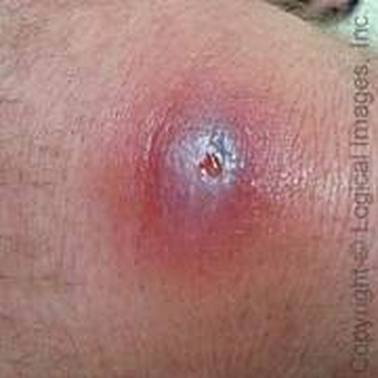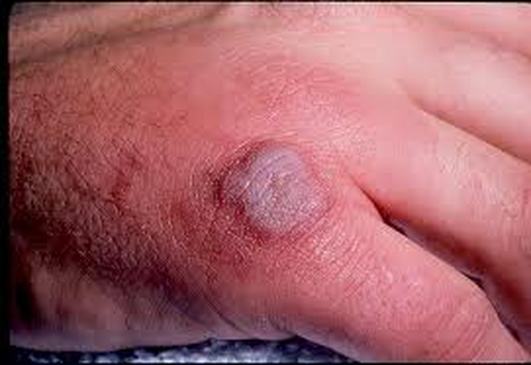MRSA: The Infection
Causes and Risk Factors

MRSA is a strain of Staphylococcus aureus bacteria. Staphylococcus aureus is a common type of bacteria normally found on the skin and nasal passage of the physically healthy. The MRSA infection only occurs when these bacteria enter the body through a cut, sore, breathing tube, or catheter. This infection may be either minor or major, the majority being minor. Major infections are more common in those with a weak immune system, while minor infections may occur in anyone.
The two types of MRSA are Hospital-acquired MRSA (HA-MRSA) and Community-acquired MRSA (CA-MRSA). HA-MRSA is acquired by those who have recently been in a hospital or healthcare facility including, but not limited to, those who have recently had surgery. This form of MRSA is largely responsible for many hospital-acquired staph infections. CA-MRSA is aquired by those who are otherwise healthy, but may have come into contact with the bacteria commonly through sharing equipment as athletes or being in a day care facility.
Serious MRSA infections may lead to:
. Blood poisoning (sepsis)
. Cellulitis
. Endocarditis (Infection of heart valves)
. Pneumonia
. Toxic Shock Syndrome
The two types of MRSA are Hospital-acquired MRSA (HA-MRSA) and Community-acquired MRSA (CA-MRSA). HA-MRSA is acquired by those who have recently been in a hospital or healthcare facility including, but not limited to, those who have recently had surgery. This form of MRSA is largely responsible for many hospital-acquired staph infections. CA-MRSA is aquired by those who are otherwise healthy, but may have come into contact with the bacteria commonly through sharing equipment as athletes or being in a day care facility.
Serious MRSA infections may lead to:
. Blood poisoning (sepsis)
. Cellulitis
. Endocarditis (Infection of heart valves)
. Pneumonia
. Toxic Shock Syndrome
Signs and Symptoms

The MRSA infection generally causes a swollen, red, painful area on the skin. Symptoms of a minor infection include:
. Fever
. Skin abscess, or pus that causes swelling
. Warmth around infected area
. Drainage of fluid from area
Symptoms of a more serious infection may include:
. Shortness of breath
. Fatigue
. Chest pain
. Cough
. Chills
. Headache/muscle ache
. General ill feeling
. Rash
. Fever
. Skin abscess, or pus that causes swelling
. Warmth around infected area
. Drainage of fluid from area
Symptoms of a more serious infection may include:
. Shortness of breath
. Fatigue
. Chest pain
. Cough
. Chills
. Headache/muscle ache
. General ill feeling
. Rash
Treatment for MRSA Infection
Treatment for a minor infection may include:
. Clindamycin
. Daptomycin
. Doxycycline
. Tetracycline
. Linezolid
. Minocycline
. Trimethoprim
. Vancomycin
Treatment for a major infection may include:
. Kidney dialysis
. Oxygen support
. Fluids/medications given through vein
. Clindamycin
. Daptomycin
. Doxycycline
. Tetracycline
. Linezolid
. Minocycline
. Trimethoprim
. Vancomycin
Treatment for a major infection may include:
. Kidney dialysis
. Oxygen support
. Fluids/medications given through vein
